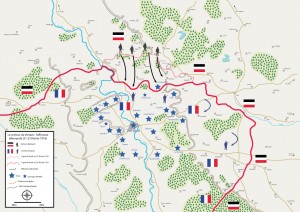On 21 February 1916, at 7 o’clock in the morning French positions came under a deluge of iron and an uninterrupted sea of fire lasting over 9 hours from the German artillery composed of 1,200 guns and 200 howitzers of all sizes. Facing the German lines, the French positions that formed a salient through which flowed the Meuse River were easy to encircle and to shell.
 In the late afternoon, the German infantry launched its offensive on a six division front of 12 kilometres. French trenches that could hardly sustain an effective defence against the incessant pounding were almost pulverized. The French opposed a fierce and desperate resistance against the German advance especially at Caures Wood where Colonel Emile Driant was killed. Although the French managed to repulse the German attacks on Herbebois and Haumont Woods, they were forced to retreat as the German infantry continued to drive them from their first line of defence.
In the late afternoon, the German infantry launched its offensive on a six division front of 12 kilometres. French trenches that could hardly sustain an effective defence against the incessant pounding were almost pulverized. The French opposed a fierce and desperate resistance against the German advance especially at Caures Wood where Colonel Emile Driant was killed. Although the French managed to repulse the German attacks on Herbebois and Haumont Woods, they were forced to retreat as the German infantry continued to drive them from their first line of defence.
On 25 February, acting with plenipotentiary authority as General Joffre’s Chief of Staff, General Edouard de Castelnau ordered to defend the positions on right bank of the Meuse at all costs, in particular the line on the Meuse Heights a natural barrier barring the Germans from making a westward advance, south of Fort Douaumont. Despite all these efforts, on the same evening the Germans took Fort of Douaumont, a fortress that had been partly disarmed as most defensive works surrounding Verdun were in August 1915. Following the first few days of intense fighting at the price of enormous sacrifices and taking advantage of the absence of reinforcements that prevented the Germans from counterattacking, a weakened French Army found it possible to save enough time to bring reinforcements and take the appropriate measures for the defence of the city.


Ajouter un commentaire